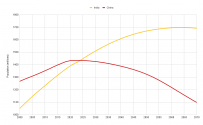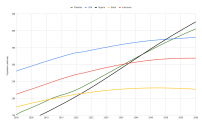Lethe
Captain
While we are waiting for the COVID-delayed 2022 edition of the UN's World Population Prospects publication, I thought it would be interesting to use the old 2019 edition to look at some of the interesting developments in global demography that are often masked by the headline trends with which most of us are familiar, i.e. China/India/USA.
Let us start by looking at the evolving population dynamics of the four next largest nations: Indonesia, Brazil, Pakistan and Nigeria.
Here are the numbers from a generation ago (2000):
Indonesia: 212m
Brazil: 175m
Pakistan: 142m
Nigeria: 122m
In 2017, Pakistan overtook Brazil with each nation having approximately 208m people.
As of 2021 the rankings hold but the field has closed up:
Indonesia: 276m
Pakistan: 225m
Brazil: 214m
Nigeria: 211m
In 2022, Nigeria is expected to surpass Brazil with populations of 217m and 215m respectively.
Over the coming years, Pakistan will progressively close the gap on Indonesia, surpassing it by 2048 at 331m people (roughly the population of USA today). Meanwhile Nigeria will downshift and fly past both Pakistan and Indonesia at redline RPMs.
The estimates for 2035 are as follows:
Indonesia: 310m
Nigeria: 295m
Pakistan: 283m
Brazil: 227m
Nigeria is projected to surpass....
Pakistan by 2030 at 263m people.
Indonesia by 2039 at 322m people.
USA by 2047 at 379m people.
Let us start by looking at the evolving population dynamics of the four next largest nations: Indonesia, Brazil, Pakistan and Nigeria.
Here are the numbers from a generation ago (2000):
Indonesia: 212m
Brazil: 175m
Pakistan: 142m
Nigeria: 122m
In 2017, Pakistan overtook Brazil with each nation having approximately 208m people.
As of 2021 the rankings hold but the field has closed up:
Indonesia: 276m
Pakistan: 225m
Brazil: 214m
Nigeria: 211m
In 2022, Nigeria is expected to surpass Brazil with populations of 217m and 215m respectively.
Over the coming years, Pakistan will progressively close the gap on Indonesia, surpassing it by 2048 at 331m people (roughly the population of USA today). Meanwhile Nigeria will downshift and fly past both Pakistan and Indonesia at redline RPMs.
The estimates for 2035 are as follows:
Indonesia: 310m
Nigeria: 295m
Pakistan: 283m
Brazil: 227m
Nigeria is projected to surpass....
Pakistan by 2030 at 263m people.
Indonesia by 2039 at 322m people.
USA by 2047 at 379m people.



